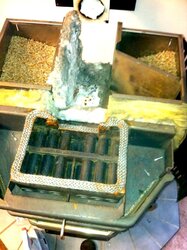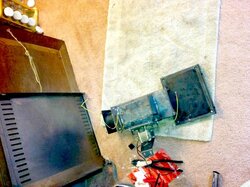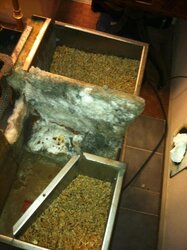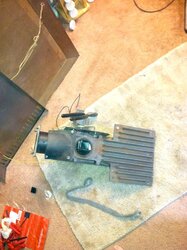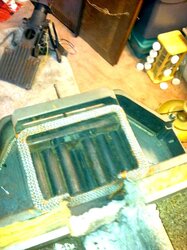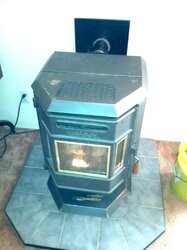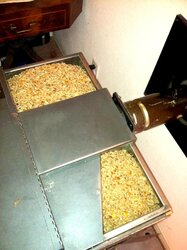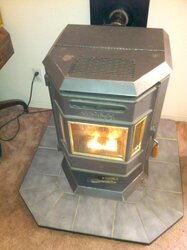We bought the little whit used back in the winter of 2009 and I installed it as a helper for real cold weather and to take care of the "shoulders" when only a small fire is needed to heat the house.
The family though I was crazy, having 3 stoves on the one floor, Haaaaaaaaaaaaaaaa, soon everyone was quite convinced that I knew Waaaaaaaaaaaasup, and had a real worthy plan.
Not to mention being a backup if the large Whit goes down.
A stove in every corner my daughter remarked from time to time with a roll of the eyes.
I still have 2 "stovable" corners left, so all bets are off.
Anyway, I am recovering from having my Left kidney removed on April 1 and still very sore, but the little Whit has been acting up for the past two weeks and burning with a very lazy fire, Hmmmmmmmmmmmmmmm, ???????
This stove has no ash traps or baffles, ????????? The exhaust fan is mounted in the top of the stove in a casting with a sheet metal box bolted to it that houses the fan assembly.
The stove was as far as I could see, CLEAN but the fire was lazy and sooting up the glass in less than a days burn. ?????????
Multiple sucks with the leaf blower had done little good in rectifying the issue.
OOOOOOOOOOK, time to rip it apart.
I unhooked the beast at the quick connect flange and slid it out to gain good access.
Off with top, sides, back etc to see wassssssup in there.
The service manual IS VAGUE to say the least, but a bit of snooping with a flashlight revealed the way it comes apart.
Removing the exhaust fan casting and assembly quickly revealed the problem, the entire area over the heat exchangers and the entrance into the fan housing was totally plugged with what looked like charcoal.
Just a lot of years of collecting soot and such had finally plugged the little beast up tight with crud.
The soft gasket rope that sealed all the components came off in hard chunks, so new stuff was needed.
I finished ripping the thing apart and cleaned it all up good, then off to Ace hardware to get some new rope seal and high temp silicone.
The design is not bad, but getting the rope seal all stuck correctly is a tad tedious, as it has to be spot on to seal right.
I replaced the exhaust fan with a new one, as a stack/fan housing fire a while back had caused the old one to warp and vibrate some.
So, with all the gasket rope siliconed to the fan box and the assembly back together it was time to tackle the main heat exchanger housing and goop the rope on there as well.
All done with that part, and getting tired and sore, I decided to let the silicone cure on the heat exchanger housing so the rope would not move when I drop the fan casting assembly back into the stove.
My plan is to get things back together today and fire the beast tonight.
All told, things look very good inside the little stove, with the heat tubes in very good shape and everything else fine as well.
I am toying with the idea of cutting a hole in the front of the heat exchanger housing and making a removable cover plate for it, thus allowing periodic cleaning access, rather than having to tear the stove apart to clean it out.
But for now, things look good.
I will update things after I fire the beast back up, which I hope is soon, as the big whit is toooooooooo much stove for this time of year.
Snowy
The family though I was crazy, having 3 stoves on the one floor, Haaaaaaaaaaaaaaaa, soon everyone was quite convinced that I knew Waaaaaaaaaaaasup, and had a real worthy plan.
Not to mention being a backup if the large Whit goes down.
A stove in every corner my daughter remarked from time to time with a roll of the eyes.
I still have 2 "stovable" corners left, so all bets are off.
Anyway, I am recovering from having my Left kidney removed on April 1 and still very sore, but the little Whit has been acting up for the past two weeks and burning with a very lazy fire, Hmmmmmmmmmmmmmmm, ???????
This stove has no ash traps or baffles, ????????? The exhaust fan is mounted in the top of the stove in a casting with a sheet metal box bolted to it that houses the fan assembly.
The stove was as far as I could see, CLEAN but the fire was lazy and sooting up the glass in less than a days burn. ?????????
Multiple sucks with the leaf blower had done little good in rectifying the issue.
OOOOOOOOOOK, time to rip it apart.
I unhooked the beast at the quick connect flange and slid it out to gain good access.
Off with top, sides, back etc to see wassssssup in there.
The service manual IS VAGUE to say the least, but a bit of snooping with a flashlight revealed the way it comes apart.
Removing the exhaust fan casting and assembly quickly revealed the problem, the entire area over the heat exchangers and the entrance into the fan housing was totally plugged with what looked like charcoal.
Just a lot of years of collecting soot and such had finally plugged the little beast up tight with crud.
The soft gasket rope that sealed all the components came off in hard chunks, so new stuff was needed.
I finished ripping the thing apart and cleaned it all up good, then off to Ace hardware to get some new rope seal and high temp silicone.
The design is not bad, but getting the rope seal all stuck correctly is a tad tedious, as it has to be spot on to seal right.
I replaced the exhaust fan with a new one, as a stack/fan housing fire a while back had caused the old one to warp and vibrate some.
So, with all the gasket rope siliconed to the fan box and the assembly back together it was time to tackle the main heat exchanger housing and goop the rope on there as well.
All done with that part, and getting tired and sore, I decided to let the silicone cure on the heat exchanger housing so the rope would not move when I drop the fan casting assembly back into the stove.
My plan is to get things back together today and fire the beast tonight.
All told, things look very good inside the little stove, with the heat tubes in very good shape and everything else fine as well.
I am toying with the idea of cutting a hole in the front of the heat exchanger housing and making a removable cover plate for it, thus allowing periodic cleaning access, rather than having to tear the stove apart to clean it out.
But for now, things look good.
I will update things after I fire the beast back up, which I hope is soon, as the big whit is toooooooooo much stove for this time of year.
Snowy


